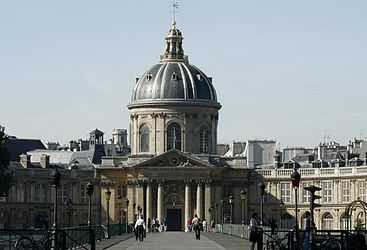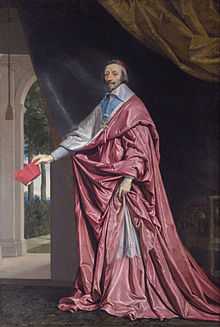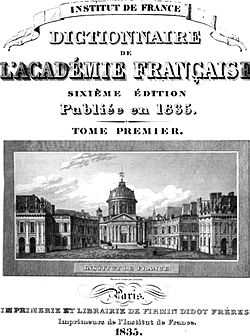Académie française
 | |
| Motto |
À l'immortalité (To immortality) |
|---|---|
| Formation | 22 February 1635 |
| Headquarters | Paris, France |
Membership | 40 members known as les immortels (immortals) |
General Secretary | Hélène Carrère d'Encausse |
| Website | Académie française website |
The Académie française (French pronunciation: [akademi fʁɑ̃ˈsɛz]), also called the French Academy, is the pre-eminent French learned body on matters pertaining to the French language. The Académie was officially established in 1635 by Cardinal Richelieu, the chief minister to King Louis XIII.[1] Suppressed in 1793 during the French Revolution, it was restored in 1803 by Napoleon Bonaparte.[1] It is the oldest of the five académies of the Institut de France.
The Académie consists of forty members, known as les immortels (immortals).[2] New members are elected by the members of the Académie itself. Academicians hold office for life, but they may be removed for misconduct. Philippe Pétain, named Marshal of France after the victory of Verdun in World War I, was elected to the Academy in 1931 and, following his governorship of Vichy France in World War II, was forced to resign his seat in 1945.[3] The body has the task of acting as an official authority on the language; it is charged with publishing an official dictionary of the language. Its rulings, however, are only advisory, not binding on either the public or the government.

History

The Académie's origins occur in an informal literary group that grew out of the salons held at the Hôtel de Rambouillet, during the late 1620s and early 1630s. The group began meeting at Valentin Conrart's house, seeking informality. There were then nine members. Cardinal Richelieu, the chief minister of France, took the body under his protection, and in anticipation of the formal creation of the academy, new members were appointed in 1634. On 22 February 1635, at Richelieu's urging, King Louis XIII granted letters patent formally establishing the body; according to the letters patent registered at the Parlement de Paris on 10 July 1637,[1] the Académie française was "to labor with all the care and diligence possible, to give exact rules to our language, to render it capable of treating the arts and sciences". The Académie française has remained responsible for the regulation of French grammar, spelling, and literature.
Richelieu's model, the first academy devoted to winnowing out the "impurities" of a language, was the Accademia della Crusca, founded in Florence in 1582, which formalized the already dominant position of the Tuscan dialect of Florence as the model for Italian; the Florentine academy had published its Vocabolario in 1612.[4]
During the French Revolution, the National Convention suppressed all royal academies, including the Académie française. In 1792, the election of new members to replace those who died was prohibited; in 1793, the academies were themselves abolished. They were all replaced in 1795 by a single body called the Institut de France, or Institute of France. Napoleon Bonaparte, as First Consul, decided to restore the former academies, but only as "classes" or divisions of the Institut de France. The second class of the Institut was responsible for the French language, and corresponded to the former Académie française. When King Louis XVIII came to the throne in 1816, each class regained the title of "Académie"; accordingly, the second class of the Institut became the Académie française. Since 1816, the existence of the Académie française has been uninterrupted.
The President of France is the "protector" or patron of the Académie. Cardinal Richelieu originally fulfilled this role; upon his death in 1642, Pierre Séguier, the Chancellor of France, succeeded him. King Louis XIV took over the function when Séguier died in 1672; since then, the French head of state has always served as the Académie's protector. From 1672 to 1805, the official meetings of the Académie were held at the Louvre; since 1805, the Académie française has met at the Collège des Quatre Nations (now known as the Palais de l'Institut). The remaining academies of the Institut de France also meet at the Palais de l'Institut.
Membership
The Académie française has forty seats, each of which is assigned a separate number. Candidates make their applications for a specific seat, not to the Académie in general: if several seats are vacant, a candidate may apply separately for each. Since a newly elected member is required to eulogize his or her predecessor in the installation ceremony, it is not uncommon that potential candidates refuse to apply for particular seats because they dislike the predecessors so much that even an enormous exercise in tact will not suffice.
Members are known as les Immortels (the Immortals) because of the motto, À l'immortalité ("To Immortality"), that appears on the official seal of the charter granted by Cardinal Richelieu.[2]
One of the Immortels is chosen by his or her colleagues to be the Académie's Perpetual Secretary. The Secretary is called "Perpetual" because the holder serves for life, although he or she may resign, and may thereafter styled as Honorary Perpetual Secretary; indeed the three post-World War II Perpetual Secretaries resigned due to old age. The Perpetual Secretary acts as a chairperson and chief representative of the Académie. The two other officers, a Director and a Chancellor, are elected for three-month terms. The most senior member by date of election, is the Dean of the Académie.
New members are elected by the Académie itself. (The original members were appointed.) When a seat becomes vacant, a person may apply to the Secretary if she or he wishes to become a candidate. Alternatively, existing members may nominate other candidates. A candidate is elected on a majority of votes from voting members. A quorum is twenty members. If no candidate receives an absolute majority, another election must be held at a later date. The election is valid only if the protector of the Académie, the President of France, grants his approval. The President's approbation, however, is only a formality. (There was a controversy about the candidacy of Paul Morand, whom Charles de Gaulle opposed in 1958. Morand was finally elected ten years later, and he was received without the customary visit, at the time of investiture, to the Élysée palace.)

The new member is then installed at a sitting of the Académie. The new member must deliver a speech to the Académie, which includes a eulogy for the member being replaced. This is followed by a speech made by one of the members. Eight days thereafter, a public reception is held, during which the new member makes a speech thanking his or her colleagues for their election. Once, a member (Georges de Porto-Riche) was not accorded a reception because the eulogy he made of his predecessor was not considered satisfactory, and he refused to rewrite it. Georges Clemenceau refused to be received because he feared that he might be received by his enemy, Raymond Poincaré.
Members remain in the Académie for life. However, the body may expel an academician for grave misconduct. The first expulsion came in 1638, when Auger de Moléon de Granier was removed for theft. The most recent expulsions came at the end of the Second World War; Abel Bonnard, Abel Hermant, Philippe Pétain, and Charles Maurras were all excluded for their association with the Vichy regime. In total, twenty members have been expelled from the Académie.
There have been a total of 726 immortels,[2] of whom eight have been women (the first woman, Marguerite Yourcenar, was elected in 1980 — besides the eight elected women, 25 women were candidates, the first one in 1874). Individuals who are not citizens of France may be, and have been, elected. Moreover, although most academicians are writers, one need not be a member of the literary profession to become a member. The Académie has included numerous politicians, lawyers, scientists, historians, philosophers, and senior Roman Catholic clergymen. Five French heads of state (Adolphe Thiers, Raymond Poincaré, Paul Deschanel, Philippe Pétain, and Valéry Giscard d'Estaing) and one foreign head of state (the poet Léopold Sédar Senghor of Senegal)[5] have been members. Other famous members include Louis, duc de Broglie; Alexandre Dumas, fils; Victor Hugo; Charles, baron de Montesquieu; Émile Littré, Louis Pasteur; Henri Poincaré; and Voltaire.
Many notable French writers have not become members of the Académie française. In 1855, the writer, Arsène Houssaye, devised the expression "forty-first seat" for deserving individuals who were never elected to the Académie, either because their candidacies were rejected, because they were never candidates, or because they died before appropriate vacancies arose. Notable figures in French literature who never became academicians include Jean-Jacques Rousseau, Jean-Paul Sartre, Joseph de Maistre, Honoré de Balzac, René Descartes, Denis Diderot, Romain Rolland, Gustave Flaubert, Molière, Marcel Proust, Jules Verne, Theophile Gautier, and Émile Zola.
Uniform
The official uniform of a member is known as l'habit vert, or the green habit.[2] The habit vert, worn at the Académie's formal ceremonies, was first adopted during Napoleon Bonaparte's reorganization of the Institut de France. It consists of a long black coat and black-feathered cocked hat (officially called a bicorne),[2] both richly embroidered with golden-green leafy motifs, together with black trousers or skirt. Further, members other than clergy receive a ceremonial sword (l'épée).[2]
Role as authority on the French language

The Académie is France's official authority on the usages, vocabulary, and grammar of the French language, although its recommendations carry no legal power—sometimes, even governmental authorities disregard the Académie's rulings.
Dictionary
The Académie publishes a dictionary of the French language, known as the Dictionnaire de l'Académie française, which is regarded as official in France. A special commission composed of several (but not all) of the members of the Académie undertakes the compilation of the work.[1]
The Académie has published thirteen editions of the dictionary, of which three were preliminary, eight were complete, and two were supplements for specialised words.[6] These include:
- Preliminary editions
- Le Dictionnaire de l'Académie française (from A to Aversion), pre-edition, Frankfurt am Main, 1687
- Le Dictionnaire de l'Académie française (from A to Confiture), pre-edition, Frankfurt am Main, 1687
- Le Dictionnaire de l'Académie française (from A to Neuf), pre-edition, Paris, 1687
- Complete editions
- Le Dictionnaire de l'Académie française dedié au Roy ("1st edition"), Paris, 1694
- Nouveau Dictionnaire de l’Académie française dedié au Roy ("2nd edition"), Paris, 1718
- Le Dictionnaire de l'Académie française ("3rd edition"), Paris, 1740
- Le Dictionnaire de l'Académie française ("4th edition"), Paris, 1762
- Le Dictionnaire de l'Académie française ("5th edition"), Paris, 1798
- Dictionnaire de l'Académie française ("6th edition"), Paris, 1835
- Dictionnaire de l'Académie française ("7th edition"), Paris, 1879
- Dictionnaire de l'Académie française ("8th edition"), Paris, 1932–1935
- Supplementary editions for the sciences, arts, and technology
- Corneille, Thomas, Le Dictionnaire des Arts et des Sciences, Paris, 1694
- Barré, Louis, Complément du Dictionnaire de l’Académie française, Paris, 1842
The Académie is continuing work on the ninth edition, of which the first volume (A to Enzyme) appeared in 1992,[1] and the second volume (Éocène to Mappemonde) in 2000. In 1778, the Académie attempted to compile a "historical dictionary" of the French language; this idea, however, was later abandoned, the work never progressing past the letter A.
Conservatism
As French culture has come under increasing pressure with the widespread use of English in media and technology, the Académie has tried to prevent the Anglicization of the French language. For example, the Académie has recommended, with mixed success, that some loanwords from English (such as walkman, software and email) be avoided, in favour of words derived from French (baladeur, logiciel, and courriel respectively). Moreover, the Académie has worked to modernize French orthography. The body, however, has sometimes been criticized for behaving in an excessively conservative fashion.
A recent controversy involved the officialization of feminine equivalents for the names of several professions. For instance, in 1997, Lionel Jospin's government began using the feminine noun "la ministre" to refer to a female minister, following the official practice of Canada, Belgium and Switzerland and a common, though until then unofficial, practice in France. The Académie, however, insisted on the traditional use of the masculine noun, "le ministre", for a minister of either gender. Use of either form remains controversial.
Prizes
The Académie française is responsible for awarding several different prizes in various fields (including literature, painting, poetry, theatre, cinema, history, and translation). Almost all of the prizes have been created in the twentieth century, and only two prizes were awarded before 1780. In total, the Académie awards over sixty prizes, most of them annually.
The most important prize is the grand prix de la francophonie, which was instituted in 1986, and is funded by the governments of France, Canada, Monaco, and Morocco. Other important prizes include the grand prix du cinéma (for film), grand prix de littérature (for a literary work), the grand prix du roman (for a novel), the grand prix de poésie (for poetry), the grand prix de philosophie (for a philosophical work), and the grand prix Gobert (for a work on French history).
Opposing regional languages
The Académie française intervened in June 2008 in French parliamentary debate about regional languages (Alsatian, Basque, Breton, Catalan, Corsican, Occitan, and Francoprovençal), when it protested against constitutional protection for them.[7]
Current members
The current members of the Académie française listed by seat number:
|
Notes
See also
- Academy of Sciences
- French art salons and academies
- Conseil international de la langue française
- Language policy in France
- List of language regulators
- Montyon Prizes – prizes awarded annually by the Académie française and the Académie des sciences
- Office québécois de la langue française
References
Notes
- ↑ 1.0 1.1 1.2 1.3 1.4 "L’histoire". Academie Française official website. Retrieved 2010-01-13.
- ↑ 2.0 2.1 2.2 2.3 2.4 2.5 "Les immortels". Academie Française official website. Retrieved 2014-01-07.
- ↑ Sanche de Gramont, The French: Portrait of a People, G.P. Putnam's Sons, New York, 1969, p. 270
- ↑ Einar Ingvald Haugen and Anwar S. Dil, The Ecology of Language, (Stanford University Press) p. 169.
- ↑ "Message from Mister Leopold Sedar Senghor, President of the Republic, to the Senegalese People". World Digital Library. Retrieved 28 April 2013.
- ↑ Classiques Garnier numérique, Corpus of Dictionaries of the French Academy (from the 17th to the 20th Century), Retrieved 2011-03-17
- ↑ Allen, Peter (16 August 2008). "France's L'Académie française upset by rule to recognise regional tongues". The Daily Telegraph (London). Retrieved 23 April 2010.
- Sources
- Vincent, Leon H. (1901). The French Academy. Boston: Houghton Mifflin.
External links
| Wikimedia Commons has media related to Académie française. |
- L'Académie française (French)
- L'Académie française from the Scholarly Societies project.
-
 "The French Academy". Catholic Encyclopedia. New York: Robert Appleton Company. 1913.
"The French Academy". Catholic Encyclopedia. New York: Robert Appleton Company. 1913. - Dictionnaire de l'Académie française, neuvième édition (French)